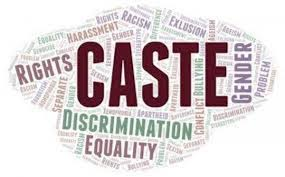This article will seep into the intricate web of similarities between the Indian Caste System and the Apartheid movement, illuminating the historical context, socio-cultural implications, and the struggle for justice that unites them.
 |
| Source - gstatic.com |
The Origins of Discrimination:
Both the Indian Caste System and the Apartheid movement emerged from historical roots deeply intertwined with colonialism and power structures. The Caste System has its origins in ancient India, where it was initially conceived as a social hierarchy based on occupation and birth. Over centuries, it evolved into a rigid system that categorized individuals into distinct castes, determining their social, economic, and political status. In a similar vein, the Apartheid system in South Africa developed during the colonial era as a tool of racial segregation, enforcing a white minority's dominance over the majority non-white population.
Cultural Segregation:
One of the most striking parallels between these two systems is the way they perpetuated cultural segregation. In India, caste identity often dictates one's marriage, occupation, and social circle. Similarly, Apartheid in South Africa enforced strict separation in all aspects of life, from education to public facilities, thereby suppressing the cultural interactions of different racial groups.
Social and Economic Disparities:
Both the Caste System and Apartheid imposed significant social and economic disparities. In India, the caste one is born into heavily influences access to resources and opportunities, making it a formidable barrier to social mobility. Similarly, the Apartheid regime systematically denied economic opportunities to non-white South Africans, perpetuating poverty and inequality.
Struggles for Justice:
The fight for justice against these oppressive systems witnessed immense courage and determination. Figures like Dr. B.R. Ambedkar and Nelson Mandela became emblematic of these movements. Ambedkar, a prominent Indian leader, dedicated his life to fighting against the caste-based discrimination and was instrumental in drafting the Indian Constitution, which sought to eradicate caste inequalities. In South Africa, Nelson Mandela emerged as a global icon in the battle against Apartheid, ultimately becoming the nation's first black president and dismantling the oppressive regime.
Global Awareness:
The parallels between these systems have drawn the attention of global communities and scholars alike. Both have been widely criticized, leading to international movements advocating for social justice and equality. United Nations resolutions and global initiatives have worked to eliminate these forms of discrimination, raising awareness of the issues on a worldwide scale.
Crossroads of Discrimination:
While the Indian Caste System and Apartheid movement may seem worlds apart, they share a fundamental characteristic: the systematic oppression of a particular group based on characteristics beyond their control, whether it be caste or race. This grim reality connects them in the shared struggle for equality and justice.
A Call for Reflection:
In concluding, it's essential to reflect on these parallels and recognize that discrimination, regardless of its manifestation, is a stain on humanity's collective conscience. By exploring the commonalities between the Indian Caste System and the Apartheid movement, we shed light on the insidious nature of these systems and gain a deeper understanding of the universality of human struggles for equality and justice.
As we strive for a more inclusive and equitable world, it is crucial to learn from history and remain vigilant against any form of discrimination. These parallels serve as a powerful reminder that the fight for justice and equality is an ongoing endeavor, and it is our shared responsibility to uphold the values of humanity and social progress.
In a world that constantly evolves, also must our commitment to eradicating discrimination in all its forms. The stories of those who stood up against the Indian Caste System and the Apartheid movement remind us of the power of the human spirit to overcome even the most entrenched forms of oppression. It is a testament to the indomitable human will and the belief that a better, more equitable world is not just a dream but an achievable reality.
A Call for Reflection:
In concluding, it's essential to reflect on these parallels and recognize that discrimination, regardless of its manifestation, is a stain on humanity's collective conscience. By exploring the commonalities between the Indian Caste System and the Apartheid movement, we shed light on the insidious nature of these systems and gain a deeper understanding of the universality of human struggles for equality and justice.
As we strive for a more inclusive and equitable world, it is crucial to learn from history and remain vigilant against any form of discrimination. These parallels serve as a powerful reminder that the fight for justice and equality is an ongoing endeavor, and it is our shared responsibility to uphold the values of humanity and social progress.
In a world that constantly evolves, also must our commitment to eradicating discrimination in all its forms. The stories of those who stood up against the Indian Caste System and the Apartheid movement remind us of the power of the human spirit to overcome even the most entrenched forms of oppression. It is a testament to the indomitable human will and the belief that a better, more equitable world is not just a dream but an achievable reality.
Written by - Anushka Dabhade
This article has been authored exclusively by the writer and is being presented on Eat My News, which serves as a platform for the community to voice their perspectives. As an entity, Eat My News cannot be held liable for the content or its accuracy. The views expressed in this article solely pertain to the author or writer. For further queries about the article or its content you can contact on this email address - anushka.author16@gmail.com


.jpeg)








0 Comments